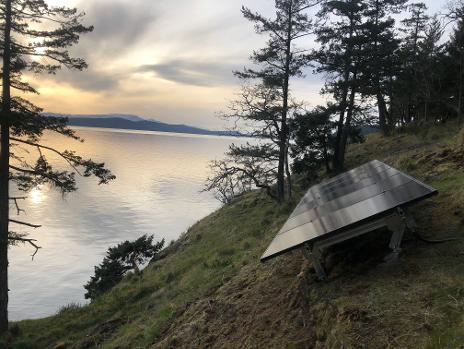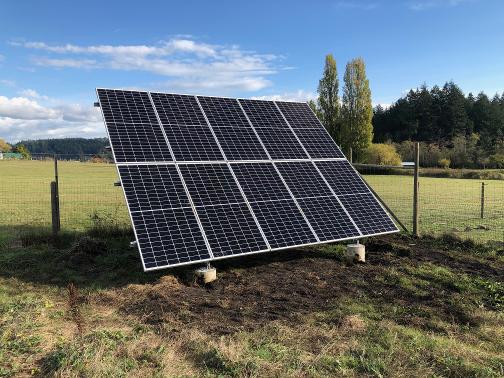Going Off-Grid
An "Off-Grid" system is essentially a stand alone power production and storage station. Solar power from the PV solar panels charge a large battery bank with the help of a charge controller. A power inverter then takes that battery power and converts to regular household AC power. When there is not enough solar power to keep the batteries sufficiently charged, alternate power sources must kick in (such as a gas/diesel/propane generator) to supply the charge current. An off-grid setup can be built to virtually any size and/or requirement. From the smallest single panel system for Vans, RVs, remote pump houses etc. right up to powering full size homes year round, free from BC Hydro and the threat of power outages. We can confidently build the system that is right for you.

Power security
Having lived and raised our children completely off-grid for the last 18 years, we have had our share of lessons on what it takes to develop a comfortable off grid lifestyle. Although there are always compromises to be made, one of the largest benefits is having uninterrupted power, even during the most severe weather. In the heavy wind storms of 2018, most of the Southern gulf islands went without power for days to weeks. With an off-grid or hybrid system, your electricity, pressurized hot water, heat, and safety all remain secure.
Off-grid is indeed not for everyone. However, in locations that are prone to power outages, or where BC Hydro is just too expensive to bring in, it is a proven technology that should be considered.
Grid-Tied Solar PV Systems
When connecting to BC Hydro through their existing "Net-Metering" program, you can use Solar power to offset and potentially eliminate your needed "grid-power". Your Solar Array directly powers the loads in your home, saving you money, and reducing your dependency on the utility company. Every kWh of electricity you produce powers your home directly, saving you from having to purchase it from the utility. If you happen to generate more power than you consume over the course of the year, you may be eligible to receive a small payment from BC Hydro for the surplus power that you have "sold" them. This type of system does not provide "Backup" power in the case of an grid outage from a storm or similar event.

Grid Tied Systems With Battery Backup
The main purpose of a typical Net Metered "Grid-Tied" system is to off-set the power consumption that you may draw from the local Utility Company (BC Hydro). When the sun is shining, 100% of the available energy produced powers your household loads directly, or get fed back to the grid for you to use later. However, in the event of a power outage, from a storm for example, all Grid-Tied Solar PV systems must shut down for safety reasons. This means that although you may have invested in a solar array, it is of no direct use in a power outage, unless, you add a Battery Backup System. When the community's power goes out, yours won't. A battery based inverter will instantly switch to stored energy in your battery bank, specifically designed for these your loads and needs. Essential loads in your home will continue to be powered, and solar energy from the solar array will continue to charge the batteries. When grid power is restored, the system automatically returns to that source and solar power resumes feeding into the grid. There are two main design strategies for incorporating backup battery and solar power:
AC Coupling: These systems rely on typical grid tied inverters as well as DC/Battery based inverters to work together to provide backup solar charging. These systems are ideal for occasional backup power and retrofits where backup power is being added to a grid tied system.
DC Coupling: These systems are essentially an off-grid design that are also grid interactive. They rely on solar charge controllers to regulate power into the battery bank. Once the storage bank is at capacity, excess solar power is then sent to your load panel to power your home, and then back to the grid for future power credit. DC Coupled systems are ideal if there will be regular use of the stored power.

